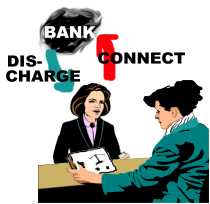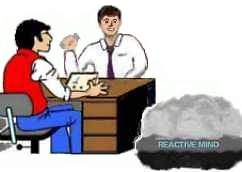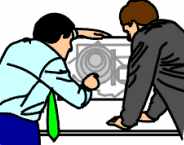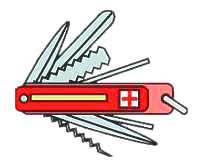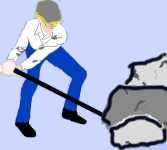Problems Processes |
|||||||||||
|
What you are seeking to accomplish on Grade One with the Problems processes, is an increased ability on the part of the pc to confront and handle problems. You don't sit down and suggest solutions or even try to make him solve his problems in session. Trying to 'solve' problems has proven unworkable as it causes a collapse of problems on the pc. The ability attained from the Grade is stated as: Able to recognize the source of problems and capable of making them vanish. Somehow the pc wants his problems. It's part of being alive. Axiom 39 states: Life poses problems for its own solution. It is a game. Axiom 48 states: Life is a game wherein theta as the static solves the problems of theta as MEST. Also, If you have a purpose in life - and that is close to be the definition of being alive - a counter-purpose will show up and now you have a problem. The basic definition of a problem is: a postulate - counter-postulate; effort - counter-effort. There are good problems and bad problems. Good problems are called challenges. Bad problems are called worries, confusions, hang ups and indecisions. It is when a delicate balance of forces develops, that we get what is usually considered problems, the stand-stills and confusions that hang up in time, multiple confusions and so on. So basically we want to increase a
pc's ability to confront and handle problems and become more causative in
the area so he will be able to handle the confusions, hang ups and
indecisions of his life and As-is most of them and move the rest of
them over into the category of challenges.
Three General Approaches There are three general approaches used on Grade One, problems. (1) There is working with the ability of the pc to be able to confront and create problems at will. (2) There is the As-ising of old problems through running past solutions. (3) Finally there is one process that makes the pc look at the prior confusion that preceded major decisions or solutions in his life. In all the processes the element of communication and ARC is of course present, which is known as an universal solvent.
As you can see in the Axioms, creating and As-ising are closely related.
In other words, the theory behind this is: when the pc can make anything into a problem at will he can unmake it as well. This can actually be understood as applying the havingness scale to problems (see below). In Creation of Human Ability R. Hubbard states: "The complete remedy of problems, of course, takes place when the preclear is convinced that he can create problems at will. Until he is so convinced, he is going to hold on to old problems. The way to Convince him that he can create problems is to have him pick out, or pick up, an object. Have him examine this object until he is sure it is real. Then ask him the question: "What problems could this object be to you?" Have him begin to name off various problems. It will be discovered at first, that he begins to drain the object itself of the problems which are inherent in the object, and then will eventually begin to invent problems. The problem should be run until the preclear is convinced that he can create problems at will. Many objects can be used rather than just one if it is discovered that the preclear's attention is fixing too strongly upon the object." (The above are in the instructions to the process 'R2-20', which is part of the Problems processes). As mentioned above, what we are doing with Confront and Create processes can be plotted on the Havingness Scale:
Usually the pc is way down this scale regarding the subject matter of the problem. It "must be confronted" but it is hard to do so; or it is "created", meaning, created by circumstances or somebody else without any idea of him having anything to do with it. You could say solutions is a substitute (see scale) for the actual confront of the problem. When running problems you will observe a lot of phenomena which can be plotted along this scale. As it can be seen from the scale, running 'confront' or running create by 'get the idea' or 'invent' you will get the pc up the havingness scale until he easily can handle his problems. Just under Create we have 'Responsible for (willing to control)', which is of course a frame of mind where the pc can deal with his problems easily.
Running Past Solutions
Another reason you don't just sit down with the pc and find 'good solutions' to the problems he has, is the relationship between Problems and Solutions. You will find they tend to form Chains. "Yesterday's solutions are today's problems" is what we usually find. You could say a 'solution' is usually a 'substitute' on the above scale. It's still short of confront. To 'solve' would just add another incident to an aberrative Chain of events. In that respect it must be noted, that the general rule of auditing is to find something earlier similar on a Chain of events in order to get an As-is'ness and resolution. you can however run past solutions with success. There is a maxim:
The old solution is what the pc is sick from. The old solutions of yesteryear or yesterday became today's problems. It is this endless Chain of cures that call for new cures that call for more drastic cures and so on. Axiom 41 states: That into which ALTER-IS-NESS is introduced becomes a problem. Solutions usually falls under that. It is no use to try to solve somebody's problems for him. So we aren't trying to give people solutions. The basic error that made a problem freeze solid is the most fundamental part of that problem; and that can be As-ised, because it's earlier on the Chain of solutions. As an auditor, you are not giving the PC new solutions for his life and livingness. You are taking out of existence old solutions, which now exist in the form of problems. You're As-ising what has been solved in the past and which caused the person to become more unaware. You are backtracking the process by going back up the way he came down. Running solutions is running yesterday's problems. You are taking out the old think that made him drop doing something about it and confronting it and become unaware. You ask for solutions. If you asked for problems, you would run it below its proper level of awareness. Because a problem, by definition, is something that you can't confront. A solution is a way by which you don't have to confront something. When you ask for problems, you are asking for something that the PC couldn't confront. When you ask for solutions, you are asking for something that the PC could confront. It's the difference between running no-confront and confront. You are actually running the same thing, but from a different point of view. If you call them problems, then you are saying the individual couldn't confront them. If you call them solutions, then you are saying he could confront them. So when you run solutions, you get rid of the problems that he sets up to avoid confronting things, by backtracking his solutions. When you do this, the PC becomes more aware and more capable of confronting, up to the point where he can confront the problems that made him decide to become unaware in the first place, and he finds that those, in turn, were solutions, so he finds out what that was a solution for, etc., and he is all set to move on out to freedom.
But let us look at a more everyday example: Let's say somebody has a bad leg. He has this injury from a sports accident. He goes to the doctor and the doctor decides, what is needed is reconstructive surgery. Our athlete gets his surgery. This is of course an Engram on top of the Engram he had from the original injury. He finds he is getting 'better', but he is not up to his old performance level that is so important to him and his game. He has to take pain killers to cope with the whole thing. He goes to rehab and has a special brace fitted on his leg. His performance gets worse and worse. But then he realizes, if he takes a heavy dose of a certain drug before a game, he can perform almost as well as he used to during the game. But this solution creates new problems for him in life, as he gets a number of additional medical problems from this; he gets less mobile and alert - all stemming from the cure. You will see something like this as a recurring situation in medicine. Not to say medicine is bad and not needed - but it has downsides. They talk about the side effects and we have these new cures that are needed to cope with the created side effects. A similar thing can be observed in politics and the effects of many 'political solutions'. The politicians agree upon a solution for the farmers, but now the consumers need a solution to cope with it. That done, the food processing companies are all upset. A new solution is needed again. Problems Collapse There seems to be a "penalty of solving" when we talk auditing. Pc's become victims of problem-collapse when they solve things. This is why people won't solve their problems, why they "have to have problems". This is true in life as well, not just auditing. Failure to make solutions (or postulates) stick elsewhere makes the thetan "believe" that solutions collapse problems on him. A process that would demonstrate this collapse would be "Invent a problem of comparable magnitude" and getting the pc to then "solve the problem" (this last of course is not "therapeutic"). A process to overcome this collapsing of problems
upon the pc is "What solution could you make stick?" Handling the Prior
Confusion The theory of this is that any fixed idea or condition is the result of a postulate made by the pc. Just prior to that postulate there was a confusion - an unconfrontable disturbance. The postulate is a stable datum, adopted in an attempt to solve that confusion. By getting off the pc's overts and withholds in the area of the confusion, one can key out the postulate and fixed condition. This approach is used in the 'Problems intensive' process. On Grade one you handle the aberrated stable datum, that was adopted after the fact by doing a Prep-check. The Prep-check system was originally developed to clean up the pc's overts and withholds in an area. It actually handles all kinds of out rudiments. We had from the definition of 'Prior confusion' above: "All stuck moments, decisions, emotions or pictures on the Time Track stick because of a prior confusion. The most stuck point on the track is a problem. The confusion occurred minutes, days, weeks before this problem. It is possible to eradicate somatics and problems by addressing the area of the confusion which occurred just before the pc noticed the problem or somatic for the first time." We have a pc, that selfdeteminedly selected a Stable Datum at a later time. It's: "A datum which keeps things from being in a confusion and around which other data are aligned." The pc made a decision (self-determined change) to
solve or put a lid on the confusion. Now the confusion still exists on his
track but are kept under lid. It holds this bad decision in place as well.
To unstick such a bad decision the prior confusion is found and cleaned up
by Prep-checking it. If you call the confusion 'a body of knowledge' you
can see the idea of the process in this definition of stable datum:
Problems and
Communication "There are numerous ways of handling PTPs. One
of them is "What communication have you left incomplete about that
problem?" A few answers and poof! no PTP. Another is "What
doesn't (that person, etc.) know about you?" Other versions of overts
and withholds can be used. These are all fast methods to get rid of
PTP's." "Still another process was "Tell me your
problem" "How does it seem to you So you can resolve many problems simply by 'completing the communications' and by getting the pc to talk about it. This element should be well understood by the auditor as well. By having good TR's, the auditor ensures that the elements of communication and understanding do their magic.
The Ability Attained on Problems Auditing:
|
|||||||||||


